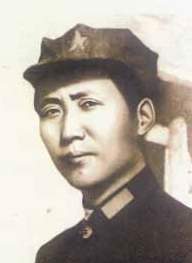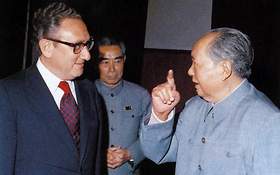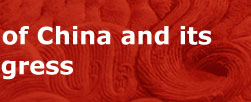|
Head of the First Generation of CPC Leaders: Mao Zedong 
|
| 2002-09-09 10:44:01 |
 Mao Zedong (1893 - 1976) was born in the village of Shao Shan, Hunan province in China on December 26, 1893. Mao Zedong (1893 - 1976) was born in the village of Shao Shan, Hunan province in China on December 26, 1893.
He was still a student when the revolution of 1911-1912 overthrew the Manchu Royal government and made China a republic.
While he was employed briefly as a library worker at the National Peking University in 1918, Mao Zedong became attracted to the ideas of Communism.
In 1921, Mao and 11 other people founded the Chinese Communist Party in Shanghai at age 27. He attended the First Congress of the Chinese Communist Party in Shanghai in July the same year. Two years later he was elected to the Central Committee of the party at the Third Congress.
From 1931 to 1934, Mao Zedong helped established the Chinese Soviet Republic in southeast China, and was elected as the chairman.
Starting in October 1934, "The Long March" began — a retreat from the southeast to northwest China.
 In 1937, Japan opened a full war of aggression against China, which made the Chinese Communist Party unite with the nationalist forces of the Kuomintang. After defeating the Japanese, the Kuomintang initiated a civil war against the Communists, during which the Chinese Communist Party defeated the Kuomintang, and established the People's Republic of China, in October 1949.
In 1937, Japan opened a full war of aggression against China, which made the Chinese Communist Party unite with the nationalist forces of the Kuomintang. After defeating the Japanese, the Kuomintang initiated a civil war against the Communists, during which the Chinese Communist Party defeated the Kuomintang, and established the People's Republic of China, in October 1949.
Mao Zedong served as the first Chairman of the People's Republic of China.
In 1966, he initiated Cultural Revolution, which lasted for 10 years and caused social and economic chaos in China.
Chairman Mao Zedong decided to establish diplomatic relations with the United States during his late years. On October 1, 1970, Chairman Mao Zedong invited American writer Edgar Snow to the National Day celebration on the Tian'anmen rostrum, sending a signal to the United States that China was willing to improve her relations with the United States.
 On December 18, Mao Zedong asked Snow to pass the message to Washington that Nixon would be welcome to Beijing for talks.
On December 18, Mao Zedong asked Snow to pass the message to Washington that Nixon would be welcome to Beijing for talks.
In 1970, China and the United States resumed talks on the ambassador level. In July and October, 1971, Dr. Henry Kissinger, national security advisor to the president of the United States, twice visited China in secret to pave the way for the visit by President Richard Nixon.
President Nixon visited China on February 21, 1972, and Chairman Mao Zedong met him at the Zhongnanhai, Beijing. On February 27, the two countries issued the Sino-US Joint Communiqu岢, marking the opening of the gate for bilateral relations.
|
|










